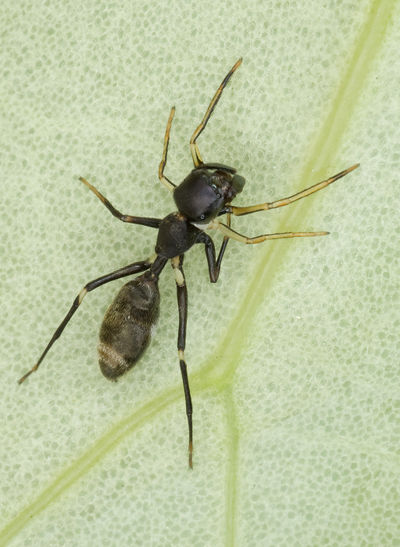Ant-Mimicking Spiders
Ants are so cool even spiders want to look like them!
Ant Models
Camponotus
 Camponotus parius worker. Photo by Ants Kingdom Asia.
Camponotus parius worker. Photo by Ants Kingdom Asia. Mimetic spider of Camponotus parius. Photo by Ants Kingdom Asia.
Mimetic spider of Camponotus parius. Photo by Ants Kingdom Asia. Mimetic spider of Camponotus parius. Photo by Ants Kingdom Asia.
Mimetic spider of Camponotus parius. Photo by Ants Kingdom Asia.
Cephalotes
 A young spider, Aphantochilus roguersi, of the family Thomisidae (crab spiders), a predator (and mimic) of Cephalotes, photographed in Manaus, Brazil, by Thiago Gomes de Carvalho.
A young spider, Aphantochilus roguersi, of the family Thomisidae (crab spiders), a predator (and mimic) of Cephalotes, photographed in Manaus, Brazil, by Thiago Gomes de Carvalho. Aphantochilus rogersi is a species of ant-mimicking crab spiders from South America. It is found from Panama to Paraguay. It mimics ants of the genus Cephalotes, which are their preferred prey. It has the unusual behaviour of carrying the dead husks of ants aloft like a protective umbrella. This may camouflage or hide its identity and allow it to approach and overpower other ants, or it may be a form of defence to protect itself from its enemies. Photo by Gil Wizen.
Aphantochilus rogersi is a species of ant-mimicking crab spiders from South America. It is found from Panama to Paraguay. It mimics ants of the genus Cephalotes, which are their preferred prey. It has the unusual behaviour of carrying the dead husks of ants aloft like a protective umbrella. This may camouflage or hide its identity and allow it to approach and overpower other ants, or it may be a form of defence to protect itself from its enemies. Photo by Gil Wizen.
Formica
 Formica japonica and mimetic spider. Photo by Seidai Nagashima.
Formica japonica and mimetic spider. Photo by Seidai Nagashima.
Polyrhachis
 A Polyrhachis-mimicking spider from Trivandrum, India. Photo by Kalesh Sadasivan.
A Polyrhachis-mimicking spider from Trivandrum, India. Photo by Kalesh Sadasivan. A spider mimic of a member of the Polyrhachis subgenus Cyrtomyrma from Cairns, Australia. Photo by Steve Shattuck.
A spider mimic of a member of the Polyrhachis subgenus Cyrtomyrma from Cairns, Australia. Photo by Steve Shattuck. A Camponotus and/or Polyrhachis mimic from Far North Queensland, Australia. Photo by Paul Zbrowoski.
A Camponotus and/or Polyrhachis mimic from Far North Queensland, Australia. Photo by Paul Zbrowoski.
Oecophylla
 Oecophylla smaragdina with mimetic spider that was detected and attacked. Photo by Pavan Ramachandra.
Oecophylla smaragdina with mimetic spider that was detected and attacked. Photo by Pavan Ramachandra.
Salticid Spiders
Myrmaplata plataleoides
Kerengga Ant-like jumpers (Myrmaplata plataleoides) have lived their entire lives disguised as weaver ants, but when it comes to love, the male spiders risk it all by revealing themselves. Batesian mimicry is perfectly manifested in the females, while the males have large jaws that, when closed, resemble a minor worker. This short video give you a quick View of the details of the spiders and their behavior. Video by Novita Listyani.
Myrmaplata plataleoides, a mimic of Oecophylla smaragdina. When approached these spiders watch and track the invader. Body length approx. 10mm, about the same size as the ant species they mimic.
Myrmarachne
Myrmarachne is an ant-mimicking genus of jumping spiders. Myrmarachne species live close to their model ant species, yet they avoid making contact with the ants. However, contact can be unavoidable at times. The consequence of contact very much depends on which body parts of both animals are involved. The most common form of contact is between the ant's antennae and the spider's first pair of legs. This resulted most frequently in the Myrmarachne running away. In contrast, when the spider's chelicerae were involved the ant would usually run away. It appears that even when there is contact between the two, Myrmarachne manage to avoid being attacked by the ant, thus remaining safe. (Ceccarelli, 2007)
References
- Ceccarelli, F.S. 2007. Contact between Myrmarachne (Araneae: Salticidae) and ants. Bulletin of the British Arachnological Society 14(2): 54-58.
- Cushing, P.E. 2012. Spider-ant associations: An updated review of myrmecomorphy, myrmecophily, and myrmecophagy in spiders. Psyche: A Journal of Entomology 2012, 1–23 (doi:10.1155/2012/151989).
- Uma, D., Durkee, C., Herzner, G. & Weiss, M. 2013. Double Deception: Ant-Mimicking Spiders Elude Both Visually- and Chemically-Oriented Predators. PLoS ONE 8(11): e79660 (DOI 10.1371/journal.pone.0079660).
| ||||||||||||||||||||||||||||||||||||||||||||||||||||||||





